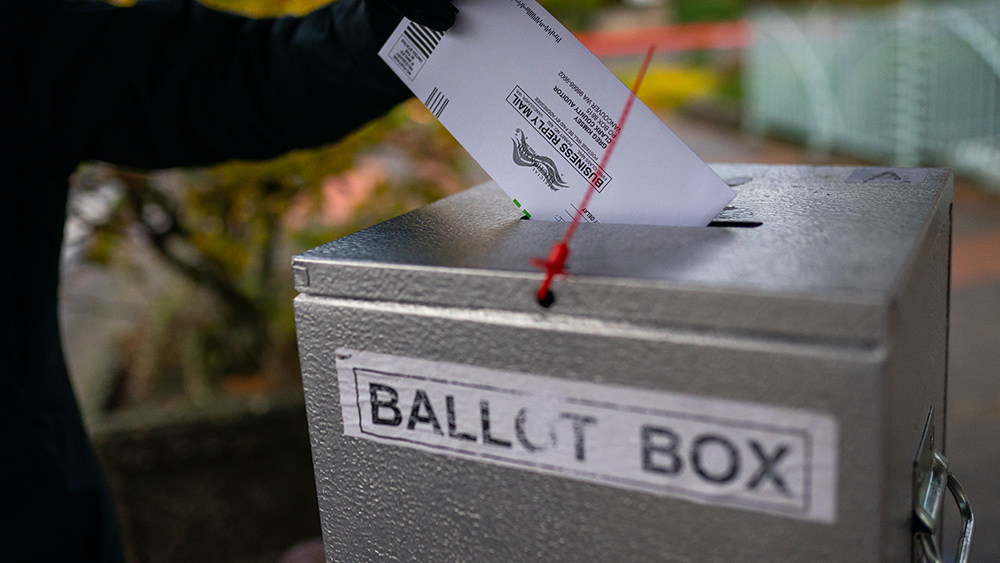
The University of Florida's Election Lab has revealed that more than 40 million people already cast their votes as early voting officially started on all seven key battleground states and over 36 other states.
According to the data from the Election Lab, 40,114,700 voters already cast their early votes, with 19,249,967 choosing in-person voting and 20,864,733 choosing mail-in ballots as of Oct. 26.
The data also shows that Democrats lead the way in early voting turnout, with approximately 5.8 million mail-in ballots compared to 4.4 million mail-in ballots of Republicans. Meanwhile, Republicans have cast more in-person ballots, with 2.6 million counts compared to the two million Democratic turnouts. (Related: Mail-in ballots need to GO if American elections will ever again have integrity.)
This substantial turnout has led to record-breaking early voting numbers in some states.
In Georgia, a pivotal state in the 2020 election, more than 25 percent of active voters have already cast their ballots. North Carolina has also seen an unprecedented turnout as over 353,000 people participated on the first day of early voting on Oct. 17, breaking the previous record set in 2020. Both states reached over two million votes as of Oct. 23, with early voting scheduled to continue through early November.
Nevada, another critical battleground state, reported that more than 397,000 voters had cast ballots as of Oct. 22, with 40 percent of those votes coming from registered Republicans.
However, David Becker, a CBS News election law contributor and executive director of the nonprofit Center for Election Innovation and Research, clarified that party affiliation alone does not predict election outcomes even though early voting trends show strong engagement. Instead, voting early only means that Americans avoid Election Day lines. This also reduces the risk of encountering disinformation and contributes to a more manageable process for election administrators.
Data company: Most key battleground states now favor Republicans
TargetSmart, a data company tracking early voting statistics, also revealed shifting dynamics in key battleground states favoring Republicans.
Historically, early voting numbers indicate a slight edge for Democrats nationwide. However, the 2024 election shows that Democrats are challenged in mobilizing their supporters in battleground areas, while Republicans have seen an increased turnout, particularly for former President Donald Trump.
For instance, data from Catalist, election officials and Edison Research highlight notable changes in Pennsylvania. As of Oct. 23, Democrats account for 61 percent of early votes in the state, down from 71 percent in 2020, while Republican participation has increased to 29 percent from 20 percent in the same period.
In North Carolina, Democrats have seen a major shift as their previous early voting advantage has completely disappeared. In 2020, they led Republicans with 40 percent to 28 percent of early votes, but now the two parties are tied at 34 percent each.
Similar trends are observed in Arizona and Nevada, where Republicans have moved ahead with 42 percent and 38 percent of early votes, respectively, while Democrats trail at 36 percent in both states. In 2020, Democrats led early voting in these states with a 42 percent to 34 percent lead in Arizona and a 44 percent to 33 percent lead in Nevada.
Moreover, local Nevada media reports that Republicans now hold an "unheard of" advantage in early in-person voting, while in North Carolina, Republicans are outpacing Democrats even in mail-in voting, traditionally a Democratic stronghold.
Follow VoteFraud.news for more news about election fraud using mail-in ballots.
Watch this video explaining how mail-in ballots are a win for Democrats.
This video is from the UAF Network channel on Brighteon.com.
More related stories:
Mail-in ballot scheme was solely about padding vote counts for Democrats.
Mail-in votes in Michigan and Pennsylvania show evidence of coordinated vote fraud for Biden.
Sources include:
Please contact us for more information.






































